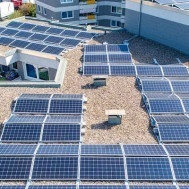The climate emergency is not a question of taking sides, but is an objective situation which cannot be ignored.
Much of Europe is experiencing winters with far fewer snow days than average, followed by exceptionally warm summers like the last two. These variations are causing record losses of ice from the glaciers in European mountain ranges. The ongoing warming and deglaciation are of unprecedented magnitude and are almost exclusively the result of greenhouse emissions caused by human activity. European mountains are warming at about twice the rate of the rest of the continent, offering a glimpse of the future, a foretaste of what will happen in a decade or so in other parts of Europe.Glaciers and ice caps, as well as snow, sea ice and permafrost, which represent the most sensitive elements of our planetary environment, have a major impact on our environment and society. The reduction and depletion of these natural resources will damage our security, economy and environment. In the mountains, these losses are compounded by increased natural instability. Glacial instability, landslides, and debris flows are now recognised as some of the most explicit evidence confirming that the transformations taking place in high altitudes are a result of global warming. It is not so much the individual events that are worrying, but the frequency and violence with which they have been occurring over the last 30 years.
As far as the reduction of glacier masses is concerned, it is essential to understand how the cryosphere influences the planet Earth and what may be the reciprocal interference with human activity. In the Alpine region in particular, it is necessary to understand the main effect it has on glaciers, water reserves (for agricultural use, primary energy production, human consumption), the economy (e.g., in energy, tourism and agricultural sectors) and on environmental and human safety (e.g. in terms of landslides, icefalls and floods).
Climate change knows no borders: it is an international problem.
Starting with transboundary areas which share the same functional ecological units, it is necessary to understand in what way governance and management of European glaciers should take climate change into account. Furthermore, as glaciers are a natural repository of climatic and environmental data and proxies, we need to ascertain how the future impact on glacier masses could accelerate the loss of historical information stored within. We also need to identify how to measure glacier evolution and build models that can improve our understanding of climate and environmental change by starting with glacier dynamics and as a result contribute directly to forecasting the future of the Alpine region
The answers to many of these questions can be found in the realm of cryospheric science and this should be the starting point for bringing together many different disciplines: geology, statistics, engineering, legal, economic and social sciences, as they can all be applied to acquire a better understanding of how glacial systems work and their environmental and social consequences. Harmonised data and tools, which are freely accessible, enable innovative, multidisciplinary and interdisciplinary research and are key to unravelling the processes responsible for these phenomena
This is the only way in which we can come to understand the glacier as a whole, i.e. as a resource to be appreciated and recognised as an important provider of multiple ecosystem services.
The next step is the drafting of guidelines for policy makers (macro-regional, national, regional and sub-regional), e.g., for the definition of water management plans, climate change adaptation strategies, mitigation and protection measures.
The involvement of local communities (especially municipalities) is of fundamental importance, since they have in depth knowledge of their local area, their water resources and their specific needs. This also serves to ensure a collective and widespread awareness of the role played by Alpine glaciers. Above all, however, without the fundamental concrete involvement of mountain municipalities, the implementation of an effective climate change adaptation policy becomes practically impossible. An understanding of the cryosphere and mountain dynamics should also be used to govern regional planning in the valleys and plains below.
The reduction of the cryosphere at high altitudes will continue to negatively affect tourism and recreational and cultural activities, but also economic development. Planning for any new facilities and infrastructures, particularly related to tourism, must be drastically reviewed.
The European Agricultural Policy (CAP) must also be redirected to align with ecological criteria, in order to encourage the resettlement of mountain areas and the re-establishment of services such as slope maintenance, fire prevention, soil erosion control, biodiversity conservation and water use.
At the same time, the problem of risk also needs to be addressed, but without prejudice or stereotypes.All too often, the response to disastrous events is to restore the ‘status quo’, or simply to implement ad hoc solutions that do not take into account territorial complexity and interconnections from a pedological, hydrological and geomorphological point of view, nor the transformations taking place. In this context, when carrying out risk assessments, it is imperative to broaden the consideration of the human and perceptive dimension. In order to improve risk management in the mountains, a wider, science-based use of Nature Based Solutions (NbS) and Green Infrastructure can come to the rescue, the latter being a strategically planned network of natural and semi-natural areas designed and managed to provide a wide range of ecosystem services in the territory.
For this to happen, it is necessary to introduce a number of actions which will form the basis from which to initiate this transition process:
- Establish channels for discussion between regional and local administrators, research groups, associations and enterprises, in order to improve governance capability for European glaciers, as well as expertise and scientific and technical know-how.
- Promote and enable the networking of experiences from different geographical, political and climatic situations.
- Create a shared network of multidisciplinary competences to set up a European Glacier Governance (EGG).
- Steer decisions made by the European Union towards the protection of glacial environments, from glaciers to ice caps, and the reduction of all negative impacts on the cryosphere and on land and water use.
- Build a European cryospheric risk monitoring system, by pooling local and regional experiences and creating a common system of rules.
- Collaborate with universities, research centers and schools to raise and increase the awareness of citizens and institutions and to develop training courses to create new professions in the field of mitigation and adaptation.
- Promote and co-ordinate international instruments and policies for climate change mitigation and adaptation in the Alps, in particular those developed by the Alpine Convention such as the Climate Action Plan 2.0, the Guidelines for Local Adaptation to Climate Change in the Alps and relative initiatives for implementation such as the “Budoia Charter for Local Adaptation to Climate Change”.
Salecina, 9 September 2023
⇒ Download pdf version
⇒ Italian version
Early signatories:
- Vanda Bonardo National Alpine Coordinator Legambiente, President CIPRA Italia (IT)
- Marco Giardino Vice-President Italian Glaciological Committee, University of Turin (IT)
- Giorgio Zampetti General Director Legambiente (IT)
- Serena Arduino Co-President CIPRA International (LI-IT)
- Federico Cazorzi Italian Glaciological Committee, Udine University (IT)
- Luca Cetara researcher Sr, Eurac Research (IT)
- Marta Chiarle researcher CNR-IRPI (IT)
- Philip Deline Savoie Mont Blanc University (FR)
- Alice De Marco Director Legambiente Piemonte e Valle d’Aosta (IT)
- Sofia Farina President Protect our winters Italia (IT)
- Cristian Ferrari Italian Glaciological Committee (IT)
- Marcel Hänggi Scientific collaborator Assocition suisse pour la protection du climat (CH)
- Felix Keller Glaciologist (CH)
- Giovanni Kappenberger meteorologist and glaciologist (CH)
- Andreas Linsbauerglaciologist GLAMOS, Freiburg University (CH)
- Valter Maggi President Italian Glaciological Committee, Bicocca University(IT)
- Barbara Meggetto President Legambiente Lombardia (IT)
- Francesco Pastorelli Director CIPRA Italia (IT)
- Miha Pavšek researcher at Anton Melik Geographical Institute ZRC SAZU (SI)
- Stefano Perona Italian Glaciological Committee (IT)
- Claudio Smiraglia Italian Glaciological Committee, formerly Milan University (IT)



